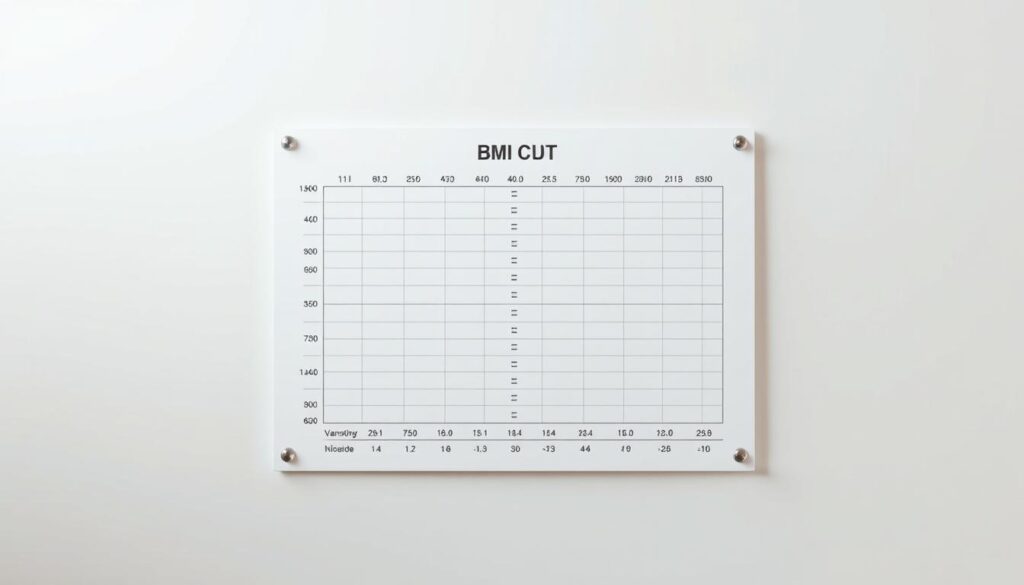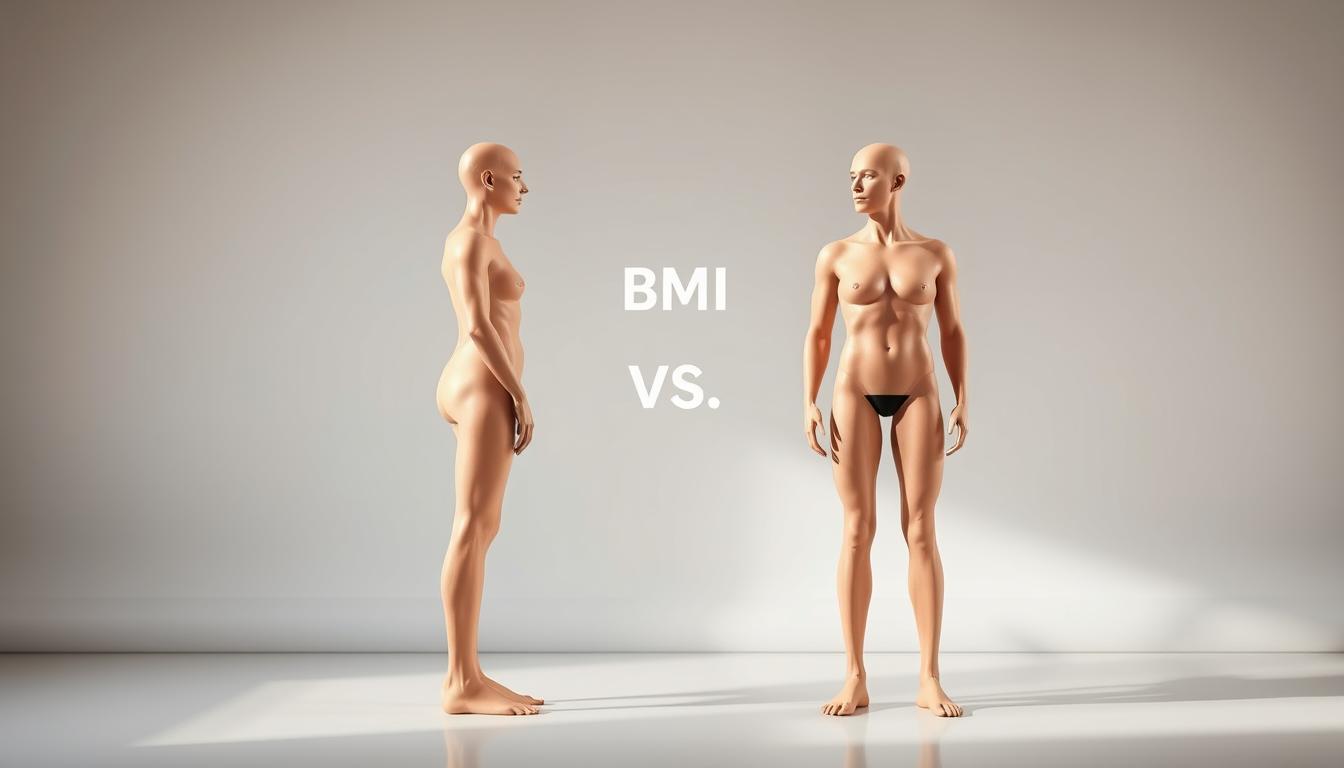Are we misjudging our health by relying solely on traditional measures like BMI calculation?
For years, body mass index or BMI has been the go-to metric for assessing weight-related health risks. But, this method has its limits. It doesn’t directly measure body fat percentage. As we explore the nuances between BMI and body fat measurement, it becomes clear that understanding both is crucial for a comprehensive view of our health.
As we dive into the world of health and fitness, making informed decisions about our well-being is key. By comparing BMI and body fat percentage, we can gain a more accurate understanding of our health risks and fitness levels.
Key Takeaways
- Understanding the difference between BMI and body fat percentage is crucial for assessing health risks.
- BMI calculation is a traditional method used to evaluate weight-related health issues.
- Body fat measurement provides a more direct assessment of health risks associated with excess fat.
- Using both metrics can offer a more comprehensive view of one’s health and fitness level.
- Relying solely on BMI may not provide an accurate picture of health.
Understanding BMI: A Quick Overview
To understand BMI, we first need to know what it measures. BMI, or Body Mass Index, uses height and weight to classify body weight.

What is BMI?
BMI is a widely used metric to check if a person’s weight is healthy for their height. It’s a simple formula we’ll look at next.
How is BMI Calculated?
The formula for BMI is: weight in kilograms divided by height in meters squared (kg/m^2). For example, if someone weighs 70 kg and is 1.75 meters tall, their BMI is 70 / (1.75)^2 = 22.86.
This number helps put people into different weight categories.
BMI Categories: What They Mean
The CDC and WHO define BMI categories. These include underweight (BMI
These categories help doctors see the risk of weight-related health issues. For instance, a high BMI might mean a higher risk of diabetes and heart disease.
But, it’s important to remember that BMI has its limits. It can’t always tell the difference between lean body mass and body fat.
Exploring Body Fat Percentage
Unlike BMI, body fat percentage gives a detailed look at health by separating fat from muscle. It’s key for understanding body composition and health risks from too much fat.
What is Body Fat Percentage?
Body fat percentage is the part of your body weight that is fat. It includes both essential fat and storage fat. Essential fat is needed for body functions, while storage fat builds up in fat tissue. Body fat percentage is a more accurate indicator of health because it shows the difference between fat and muscle, giving a clearer view of health risks.
There are different body fat percentage categories. For example, athletes usually have less body fat than the average person. On the other hand, those classified as obese have a lot more.
How is Body Fat Percentage Measured?
There are many ways to measure body fat percentage, each with its own accuracy and ease. These include:
- Hydrostatic Weighing: This is one of the most accurate methods, which involves weighing a person underwater.
- Dual-Energy X-ray Absorptiometry (DXA): Uses X-rays to find out bone mass, fat mass, and lean mass.
- Skinfold Measurements: This method pinches the skin at certain points to measure fat under the skin.
- Bioelectrical Impedance Analysis (BIA): Measures body fat by sending an electrical current through the body.

Each method has its own benefits and drawbacks. For instance, hydrostatic weighing is very accurate but needs a swimming pool. BIA is easier to use but can be less accurate depending on the device and how hydrated you are.
Knowing about body fat percentage and how to measure it helps people make better health and fitness choices. By picking the right method, you can accurately check your body composition and see changes over time.
Key Differences Between BMI and Body Fat Percentage
It’s important to know the differences between BMI and body fat percentage for a full health check. Both give insights into health, but they measure different things and have different levels of accuracy.
BMI vs Fat Percentage: Accuracy in Measurement
The debate on BMI vs body fat percentage accuracy is ongoing. BMI has its flaws, like not telling the difference between muscle and fat. For example, athletes with lots of muscle might have a high BMI but not be overweight. On the other hand, body fat percentage directly measures body composition, making it a better health indicator for some.

A study found a strong link between BMI and body fat percentage, but it varies by age and gender. This means BMI can be a good starting point, but it might not show the whole picture for everyone, like those with unusual body types.
Situations Where One is Preferable Over the Other
There are times when one metric is better than the other. For athletes or people with a lot of muscle, body fat percentage is better because it shows their body makeup accurately. On the other hand, for most people, BMI is easier and cheaper to use for a first health check.
To see which metric is more important for you, check out Goshen Health’s blog on BMI vs body fat percentage.
The Impact of BMI and Body Fat on Health
Both BMI and body fat percentage are key indicators of health. They offer different views into our overall wellness. It’s important to understand what these metrics mean for our health risks and making smart choices.
Health Risks Associated with High BMI
A high BMI can lead to serious health problems. Cardiovascular diseases are a big concern, as extra weight can cause high blood pressure and heart disease. It also raises the risk of stroke.
Also, a high BMI increases the chance of getting type 2 diabetes. This is because the body’s cells don’t respond well to insulin.
Research also links high BMI to certain cancers, like breast, colon, and kidney cancer. These risks come from chronic inflammation, insulin resistance, and hormonal changes linked to too much body fat.
Understanding the Health Implications of Body Fat Percentage
Body fat percentage gives a clearer picture of health than BMI. It shows the difference between fat and lean body mass. Visceral fat, found around the abdomen, is very risky. It’s linked to metabolic syndrome, which raises the risk of heart disease, stroke, and diabetes.
Understanding body fat percentage’s health implications means knowing the dangers of too much fat, like visceral fat. By checking body fat percentage, people can better understand their health risks. They can then take steps to reduce these risks.
Conclusion: Making Informed Health Choices
It’s important to understand BMI and body fat percentage to make smart health choices. By looking at both, you can really get to know your body and health risks.
Using Both Metrics Together
Using BMI and body fat percentage together gives a clearer view of health. This is true for athletes or those with a lot of muscle. For example, a BMI calculator can help when used with body fat measurements.
Choosing the Right Measurement
Choosing between BMI and body fat percentage depends on your health goals. Athletes might use body fat percentage to check fitness. But, people at risk for obesity-related diseases should watch both.
Visual Comparison
An infographic comparing BMI and body fat percentage can help a lot. It shows their differences and uses, making it easier to pick the right one for your health journey.


